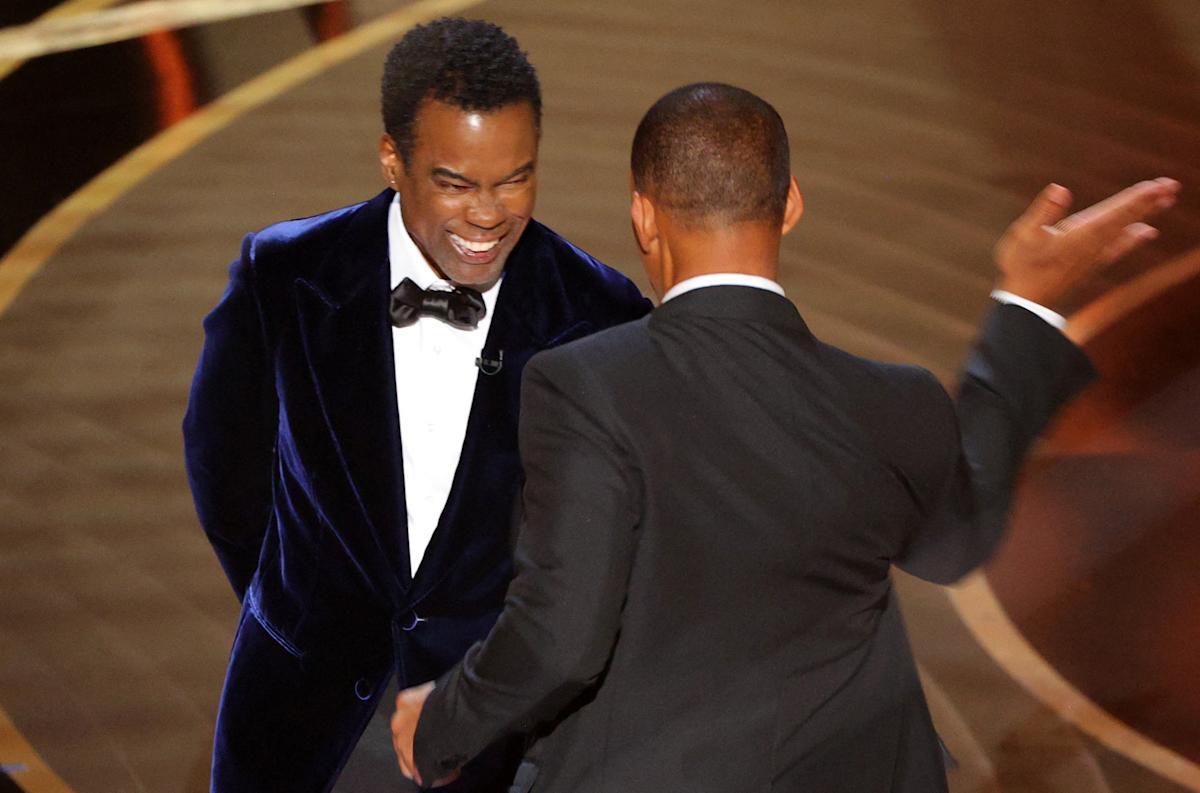Sandwiched between presenter Chris Rock’s real-time narration of “uh-oh” and then “oh, wow” was the most dramatic moment of Sunday’s Academy Awards broadcast.
Americans watching from home could see the commotion as actor Will Smith approached the stage and smacked Rock across the face.
But due to a tape delay that dropped nearly 20 seconds of audio from the broadcast, none could hear a stunned Rock tell the equally stunned audience, “Will Smith just smacked the s— out of me!” (nor could they hear Smith’s two f-bombs that followed.)
Tape delays have been a staple of live broadcasts for decades. They give stations enough wiggle room to bleep, blur or otherwise dump embarrassing gaffes – or, more crucially, content that could draw a Federal Communications Commission (FCC) fine on domestic broadcasts.
But as Sunday’s Oscars proved, some of the old rules of regulating content may have met their match in the internet era.
Many international audiences saw and heard the whole messy affair.
David Mack watched an unedited version of the broadcast in Sydney on the Australian Channel Seven when he saw friends in the United States complaining on Twitter about ABC overriding the audio of the domestic broadcast.
“I realized I had seen and heard what they had not,” Mack, a reporter for BuzzFeed News said in a message on Monday. “So I rewound and filmed that clip.”
He posted the uncensored clip to Twitter, where it quickly went viral. It was soon joined by other unedited versions of the broadcast f-rom countries such as Japan.
“You’ve got commercial [stations] broadcasting under a certain set of rules and social media using another set, and you can see how easily you can get to the cut content by going on social media,” said Jim Hatcher, the chief technology officer at Human Circuit, an engineering firm that designs broadcast systems.
“How a traditional broadcast is going to compete with that, I don’t know. And I don’t know how the FCC will address that either,” he said.
Broadcasts are typically disseminated as produced feeds – with commercial insertion or graphics – or a raw transmission known as a “clean feed.” According to Hatcher, a growing number of broadcasts are over-the-top transmissions, or OTTs, meaning they are sent directly over the internet and bypass cable or antennae connections. It’s common for clean feeds to be broadcast as OTTs, he said.
“As over-the-top transmission really becomes the way we consume content, it’s going to be harder and harder to enforce these obscenity laws and filter things out,” Hatcher said.
Broadcast regulations vary by country, but the United States has a reputation for being stricter about expletives and nudity compared to Australia, France, Britain and other areas.
Mack, the Australian reporter, said his native country is generally more relaxed about curse words.
“Our ex-PM [Kevin] Rudd went on TV and used the word s—storm, famously,” Mack said.
A radio producer for the BBC, who spoke on the condition of anonymity because the person was not authorized to speak officially on broadcast standards, said: “Americans can be a bit more puritanical and outraged by these things.”
“We don’t have a thing when you’re watching a movie [airing] at 11 a.m. and Samuel L. Jackson is calling people ‘melon farmers,’ ” he said of the American broadcast practice of overdubbing expletives for less objectionable phrases.
From the start of early broadcast history, the standard of what is considered appropriate for broadcast in the United States went largely unchanged for half a century, said Robert Thompson, a professor of TV and pop culture at Syracuse University.
“Throughout the history of radio and television, we were . . . I don’t think ‘puritanical’ would be too hyperbolic,” Thompson said. “From when radio gets started in the 1920s really into the 1970s, there was virtually no swearing or sex on TV.”
As the Oscar-nominated film “Being the Ricardos” reminded viewers, CBS in the 1950s refused to let characters in the hit sitcom “I Love Lucy” say the word “pregnant,” Thompson said.
Things began to shift by the 1970s, after the sexual revolution and the advent of cable, which the FCC doesn’t restrict as tightly as over-the-air networks. But networks grew increasingly sensitive about their own standards in the wake of Janet Jackson’s “wardrobe malfunction” during the 2004 Super Bowl, which led to the FCC being flooded with more than 500,000 complaints and a $550,000 fine for CBS Corp. (the fine was later thrown out).
A split-second flash of a nipple at 50 yards away is almost quaint when compared with popular shows that air on cable and streaming services – which face few regulations and make up a growing share of what audiences consume, Thompson said.
“We have a generation growing up watching streaming, watching ‘Euphoria’ and ‘Pam and Tommy’ where there’s a talking penis,” Thompson said. “Yes, broadcast networks remain a place where you have these traditions and regulations and standards, but here are so many other places people watch what we still call ‘television’.”
By December 2021, according to a recent report by ratings company Nielsen, audiences consumed just over a quarter of their content from broadcast, while more than 60% came from cable and streaming services.
Thompson said Sunday’s Oscars underscored a criticism that has long dogged American broadcast standards when it comes to the policing of sex and profanity.
“Last night was a violent act – and we saw the violent act,” Thompson said. “This is typical America: We see someone on live TV hit somebody. But ah, we can rest assured we didn’t hear the f-word.”
Related Content
Russia has killed civilians in Ukraine. Kyiv’s defense tactics add to the danger.
Drawing from the Black church, a psychologist pushes to reshape mental health care
The Oscars are changing, and Will Packer is the man behind the curtain




